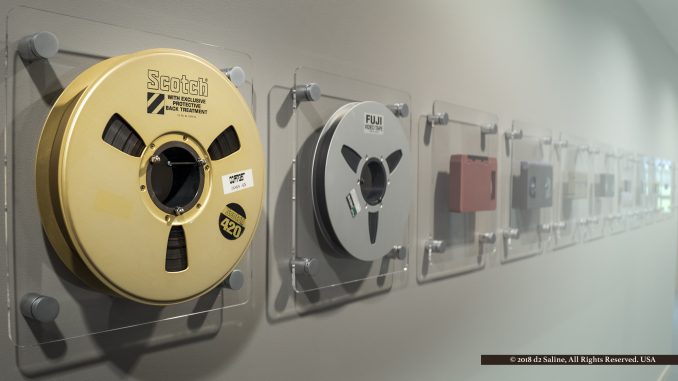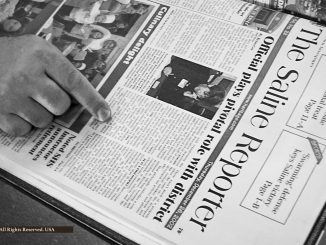
It wasn’t that many years ago when the distinction between video and still photographers was clear, lines between the two protected as if by religous doctrine. Storyboards and production crews, versus street. Narratives played out over time defined one; singular decisive moments, the other. [1,2,3,4,5,6]
Today, the option for capturing one or both commonly reside in the same device. It’s a key point of competition among smartphone choices. And everyday users seem to at least think they understand how the picture-taking part evolved over the course of their lifetimes. [7,8]
Simplistically, cameras exposed images on 35mm film. That film was developed in chemical solutions. Then that film was either used to subsequently expose special paper, which was then itelf developed to make prints, or individual frames from the film were fixed into mounts for projection onto screens for viewing. [9,10,11]
The history of videography is far more difficult story to tell. [12]
Best case, the average consumer dates the democratization of this format to the advent of YouTube — less than thirteen years ago. At its more elaborate, raw footage might be recorded to an SD Card using Canon 5D Mark III. Edit in iMovie on the Mac. Upload to the web. [13,14,15,16]
But Ann Arbor-based Russell Video pre-dates those beginnings by a full two decades in business. As company owner Dan Russell related it to Saline Journal last week, this story rightly starts out with the bulky two-inch videotape reals his father, Robert Russell, used to distribute content for airing on PBS stations. “And that was standard definition,” he emphasized. [17,18]
From that foundation, his father and brother, Dave Russell, struck out on their own in 1985. “We would edit, and we could dub and distribute videos.” Initially, they worked as a support for other area producers who were making safety, training, and corporate releases. In fact, Russell Video proved an invaluable resource in the late-1980s, early-1990s when D² Enterprises affiliated with Video Images on the creation of educational programming to advocate nascent recycling initiatives in Michigan.
Unlike still-image capture, video took a number of physically different, expensive, and at times, rapid changes from the introduction of the then-svelte Fujifilm one-inch, to pre-cloud SD Card. While continuing to support projects utilizing all of these nearly dozen interrations in-house, Mr Russell noted the numerous reconfigurations he’s had to oversee in his building layout to keep pace with change. [19]
How would a business go about telling this story?
It’s an important message for clients. We were there from the effective start. Been there, done all that.
Even if Russell Video were to close its doors, re-cast things floor-to-ceiling, then re-open as a museum, perspective would still be a prohibiting factor. Imagine constructing sets for each phase and placing them side-by-side for onlooker consideration. Or utilizing some variation on the “Carousel of Progress” approach. Even then the challenge remains that of focusing attention on the critical elements of change, challenges, and implied resolutions. [20]
Ironically, this isn’t a story appropriately told by video. Customers don’t walk into physical facilities only to sit down, watch, and absorb a running loop of any duration on television monitor.
So Dan Russell brought the problem to Saline Picture Frame. He’d gotten to know Mary Bowe through one of her previous downtown locations. Russell Video already had a wide variety of snapshots taken over the course of their thirty-plus years in the field, nicely framed and adorning walls here and there where his team is based. But for this he needed a story; he needed a singular image, immediately appreciated as a whole, then able to communicate more deeply for those who wanted more. [21]
“They actually had pieces from everything they’d worked with,” Ms Bowe told Saline Journal with a hint of amazement still evident in her voice. “So it was obvious that they’d show nicely in a line. But we wanted to give a sense of relative size for comparision between any two from history, so that led us to put them all on the exact same-size backings.
“The SD Card — everyone knows what that is,” she went on. “Well, at least today they do. I imagine you’d take as many of those out as you need for a project, and then take spares, and you’d never notice them in your pocket. All by itself, it could get lost on the backer.
But those tapes they used to use: Can you imagine? And I don’t even want to think of the devices that were needed to run it, that went along with it. You feel tired just looking at some of the early ones. Some of them seem like they are going to burst off their display backers.
The result was both simple and powerful. In no minor part, this is because each element is so uniquely physical, so real.
In the end, it’s hard to image how this story could have been told in any better way than through collaboration between video producer and frame shop. It also makes sense that this would be a path that converged the practicioners of still and moving image production. Perhaps most important of all, it has delivered yet another engaging history lesson where likely least expected.
References
- “Tech Time Machine: The Evolution of Video” Eli Epstein.
- “History of photography” Helmut Erich Robert Gernsheim, Naomi Rosenblum, Andy Grundberg, and Beaumont Newhall, Encyclopaedia Britanica.
- “Video Script Writing” Rick Allen Lippert (April 10, 2018) Lynda.
- “Street Photography Etiquette — A Beginner’s Guide” Philippa Edwards (April 9, 2016) DigitalRev.
- “6 Steps to Great Video Production” Earl Chessher (September 1, 2010) Videomaker.
- “Cartier-Bresson’s classic is back – but his Decisive Moment has passed” Sean O’Hagan (December 23, 2014) The Guardian.
- “Best camera phone 2018: the top smartphone snappers around” Gareth Beavis and John McCann (August 17, 2018) TechRadar.
- “Here’s The Epic 2,000-Year Journey The Camera Took To Make It Into Your Smartphone” Dylan Love (January 23, 2012) Business Insider.
- “1 How a Film SLR Camera Works” ILFORD Photo (February 6, 2017) YouTube.
- “6 Processing Your First Film” ILFORD Photo (February 22, 2017) YouTube.
- “Making Your First Black & White Print” (February 26, 2018) YouTube.
- “A History of the Development of the Video Camera, from Chemical Plates to SD Cards and Beyond” University of Chicago.
- “The History of YouTube” Ace X (November 10, 2016) Engadget.
- “Encyclopedia – Definition of: SD Card” PC Magazine.
- “Canon EOS 5D Mark III Review: The Best DSLR for Shooting Video” Andrew Liszewski (March 23, 2012) Gizmodo.
- “iMovie” Apple.
- “Videotape Identifier” DC Video.
- “When to buy SD, HD or UHD streaming movies and TV shows” Francis Navarro (October 5, 2017) Komando.
- “Fujifilm Video Tape Technology Milestones” Fujifilm.
- “Walt Disney Talks Creating Carousel of Progress | Walt Disney World” Disney Parks (January 12, 2015) YouTube.
- Saline Picture Frame (store page).



